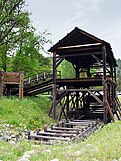User:Allard
Hello and a warm welcome to all my fellow Wikipedians. How nice of you to drop in to see who I am!
Morning>
Wikipedia & me:
[edit]How I discovered Wikipedia, I do not remember. But from being a reader I slowly became a contributor. Although I don't work that much on Wikipedia I do see myself as a Wikipedian. I don't go searching on Wikipedia what I can edit next, I edit what I find and want to do. This means I add and mainly improve a lot of small things and only rarely I make large edits.
My work:
[edit]Articles I've started on Wikipedia:
- Fort Knox Bullion Depository
- Animals are Beautiful People
- Template:David Attenborough Television Series
- Template:Malta Islands
Images I made for Wikipedia:
 Dutch lower house as from 2006
Dutch lower house as from 2006 New image of the Netherlands Air Force Roundel
New image of the Netherlands Air Force RoundelMap on membership of the League of Nations
United Nations membership map
 Improved image of the British Helgoland flag
Improved image of the British Helgoland flag New image showing the current flag of Hel(i)goland
New image showing the current flag of Hel(i)goland
Article guide:
[edit]A list of articles worth looking at, if one can find them:
- Antidisestablishmentarianism
- Ball's Pyramid
- British Isles (terminology)
- Eadweard Muybridge
- Gunpowder Plot
- Horace de Vere Cole
- Humphrey (cat)
- Islomania
- List of countries by date of nationhood
- List of flags
- List of people who died on their birthdays
- List of regnal numerals of future British monarchs
- List of unusual deaths
- Northwest Angle
- Quadripoint
- Racetrack Playa
- Rule of tincture
- San Gimignano
- Transcontinental country
- Undivided India & Partition of India
- Voyager Golden Record
- Web colors
- Winchester Mystery House
And there's always the Random article
And to all citizens of the European Union, please read this: Oneseat.eu
News
[edit]- A fire at a ski resort hotel (pictured) in Kartalkaya, Turkey, leaves at least 78 people dead and 51 others injured.
- A series of attacks by the National Liberation Army in the Catatumbo region of Colombia leaves more than a hundred people dead.
- A ceasefire agreement suspends the Israel–Hamas war, involving the release of Israeli hostages and Palestinian prisoners.
- Two Supreme Court judges are assassinated in a shooting at the Supreme Court of Iran in Tehran.
Selected anniversaries
[edit]January 24: Alasitas (La Paz, Bolivia); Day of the Unification of the Romanian Principalities (1859)
- 1458 – The Estates unanimously proclaimed 14-year-old Matthias Corvinus King of Hungary after being persuaded to do so by his uncle Michael Szilágyi.
- 1848 – James W. Marshall discovered gold at Sutter's Mill (reconstruction pictured) in Coloma, California, leading to the California gold rush.
- 1968 – Vietnam War: The 1st Australian Task Force launched Operation Coburg against the North Vietnamese army and the Viet Cong.
- 1977 – Spanish transition to democracy: Neo-fascists attacked an office in Madrid, killing five people and injuring four others.
- 1987 – About 20,000 protestors marched in a civil rights demonstration in Forsyth County, Georgia, United States.
- Signe Rink (b. 1836)
- Maria Tallchief (b. 1925)
- Madge Bellamy (d. 1990)
- Helena Kmieć (d. 2017)
Did you know...
[edit]- ... that the Jethani Temple (ruins pictured) may have collapsed under its own weight?
- ... that the T24 Festival was organized after a former soldier boasted online that he could set up a 24-person military tent by himself?
- ... that the organ console at the Loew's Jersey Theatre was originally installed at another theater by mistake?
- ... that Margaret Reid is the first woman to have served as President of the Australian Senate?
- ... that The Hangover by Toulouse-Lautrec, which features the stylistic influence of Vincent van Gogh, was once displayed by Aristide Bruant in his nightclub?
- ... that there were "jubilant" cheers from the courtroom audience when three students were acquitted of the murder of Fernando Rios?
- ... that the discontinuation of a Warsaw-based Yiddish literary journal in the summer of 1939 was unrelated to the invasion of Poland?
- ... that Olympic gold medalist Lao Lishi was one of eight bell-ringers for the Alibaba Group's listing on the New York Stock Exchange?
- ... that according to the Mercurius Aulicus, 400 soldiers were routed by six officers and a boy during the English Civil War?
Today's featured article
[edit]Slayback's Missouri Cavalry Regiment was a cavalry regiment of the Confederate States Army during the American Civil War. Formed as Slayback's Missouri Cavalry Battalion, the unit consisted of men recruited in Missouri by Lieutenant Colonel Alonzo W. Slayback (pictured) during Price's Raid in 1864. The battalion's first action was at the Battle of Pilot Knob in September; it later participated in actions at Sedalia, Lexington, and the Little Blue River. In October, the unit was used to find an alternate river crossing during the Battle of the Big Blue River and saw action at the battles of Westport, Marmiton River, and Second Newtonia. Around February 1865, the battalion reached regimental strength after more recruits joined. On June 2, 1865, the Confederate Trans-Mississippi Department surrendered. The men of the regiment were located at different points in Louisiana and Arkansas when they were paroled, leading the historian James McGhee to believe that the regiment had disbanded before the surrender. (Full article...)











